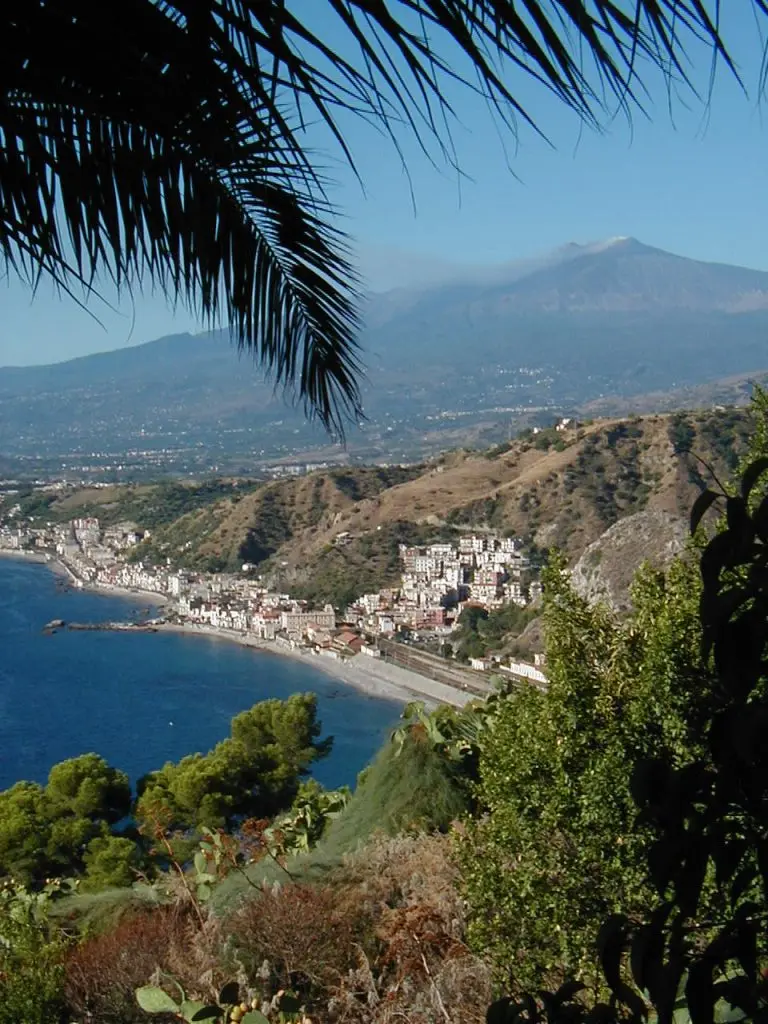In many ways Italy is one of the most diverse countries in the world. Crammed into this relatively tiny peninsula you’ll find an endless variety of local cultures, cuisines, dialects, and of course…landscapes. If you’re like me, your love of the outdoors leads you to walk and hike in as many places across the globe as possible. If it has amazing scenery, I want to trek through it! That being said, it’s no wonder that Italy is one of my favorite destinations to explore on foot, daypack in place, trekking poles in hand. The variety of the many Italian regions provide enough unique experiences to last a lifetime of trails.
Since I have been leading walking and hiking trips for many years in Italy, one of the most common questions I field is: “Where should I go hiking in Italy?” Like many questions…the answer is: “Depends.”
It depends on what you’re looking for, your ability, time of year, and various other factors. Let’s take a quick look at an overview of my favorite Italian walking and hiking regions
Italy’s 7 Best Hiking Regions
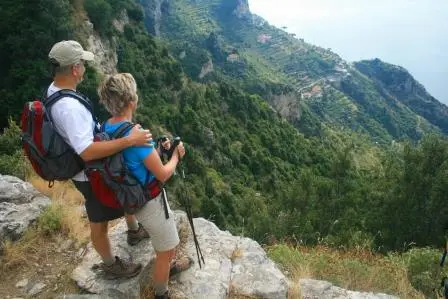
1. Italian Riviera
Starting at the border with its better-known cousin, the French Riviera, the Italian Riviera coastline runs east along the Mediterranean, ending near the border of Tuscany. The area is strikingly beautiful, with craggy mountains that butt up against the sea, and dotted with beaches and small towns. One of the more popular sections is known as the Cinque Terre, or Five Towns, and is located near the eastern end of the Italian Riviera.
The five picturesque towns have an extensive network of trails that connect them, and wind up into the terraced vineyards that overlook the towns. Another well-known area for hikers is near the town of Portofino, nearer the center of the coastline with rugged hills and spectacular ocean views.
See Our Italian Riviera & Cinque Terre Walking Tour
The trails in these regions were originally laid down centuries ago to allow the villagers to travel between towns and to escape into the mountains when seaborne marauders attacked their villages and were not necessarily built with modern tourists in mind.
Therefore, there are no cable cars to assist the ascents. There are a few places where you can take a local bus to an upper village to start your hike, but the norm is to start at one of the sea-level villages and put your boots on the trail if you want to enjoy the best views from on high.
No matter where along the Riviera you choose to hike, you’ll find that the more obvious and well-marked trails are the ones that run between the towns along the coast. The higher and more difficult-to-follow trails (with better views) are used more by the locals as they tend to their grapes and lemons. The lower trails are easily followed, and offer excellent views, but may be crowded on weekends and during the summer.
The higher trails are less crowded, but can be tricky to navigate, sometimes ending abruptly at a stone wall, forcing you to backtrack for some distance…or wandering in the wrong direction, away from your intended destination. It’s better to have a guide when exploring the trails-less-traveled.
The season for hiking runs from April to October, with the spring and the fall having the most genial weather. Summer is of course warm and sunny, but summer also brings hordes of tourists from all over Europe.
The difficulty of the trails can vary…from Easy to Challenging, but overall, most of the trails tend to be in the Intermediate to Challenging range. This is mostly due to the steepness of the terrain, the lack of cable cars for ascending, and to the length of many of the trails. Once again, using a guide can smooth the rough spots and ensure that you’re back in town in plenty of time for a glass of vino at sunset.
2. Lake Garda Region
Lago di Garda, the largest of the famed Italian Lakes, is embedded in the Alps in the northeast of Italy. The northern end of the lake is surrounded by wonderfully scenic mountains and valleys and has a delightful assortment of towns to explore…some along the lakefront and some in picturesque alpine valleys. The variety of scenery along the trails is excellent, expect dramatic lake views interspersed with verdant valleys, pine forests broken by lush alpine meadows, and backed by the snow-capped peaks of the Dolomites in the distance. Imagine a “Switzerland meets Italy” vibe.
The trail system in this area is extensive and generally well-marked. As with most trails in Italy, however, you can never fully count on the accuracy…or consistency of the trail markings. It’s best to always have a map and compass as well. Most of the trails around Garda are not serviced by cable cars, so you’ll find some ascents by foot are often in order. They need not always be difficult, however, as some will follow old roadways with a comfortable grade, and some can be accessed from higher altitudes using a car or public bus. There are plenty of trails in the Easy range to occupy a hiker of modest abilities for a week, but many more in the Intermediate and Challenging level to test the resolve of the more adventurous. A guide will be very helpful when navigating the more exciting pathways.
Despite the moderating influence of the lake, the weather window for walking and hiking around Garda is shorter than most of Italy, due to the surrounding mountains. April can still be a bit chilly, but you’ll have many of the trails to yourself. May and June see warmer temperature and an explosion of wildflowers in the meadows. The summer is also gorgeous, but can get crowded, and of course the as the temps drop in September and October, so do the numbers of tourists. The fall weather is similar to spring, though, and can provide spectacular sunshiny days until mid-October.
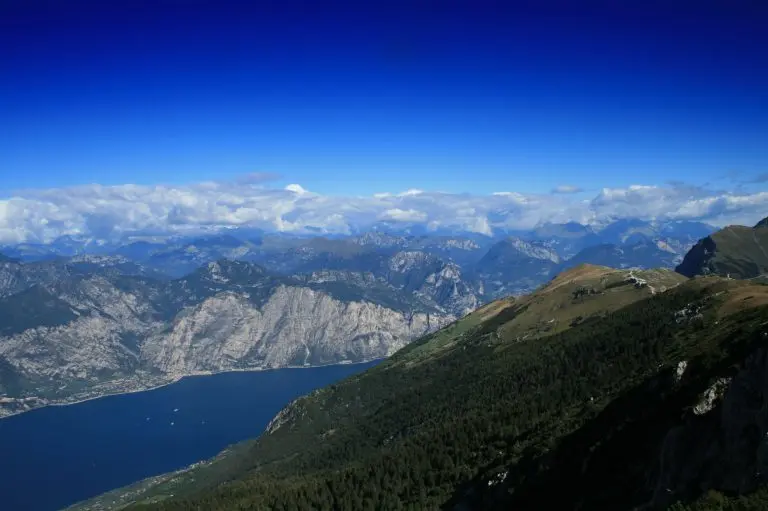
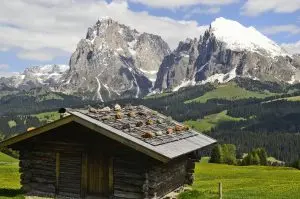
3. Dolomites
In the far northeast of Italy, nearer to Vienna than to Rome, lies the portion of the Alps known as the Dolomites. These are arguably some of the most dramatic and picturesque mountains in the world, as evidenced by the painters and filmmakers who have long been using the Dolomites as the setting for anything mountainous.
The trail system for hikes in the Dolomites is nothing short of astounding! Local trail builders have been hard at work for hundreds of years…making trails for shepherds to move their flocks to the high pastures, for villagers to travel between towns, for troops to invade in two world wars, and now for hikers to enjoy the splendor of the area.
The trails in the Dolomites tend to be well marked, with detailed maps available at outdoor stores in nearly every town. On your walks you can expect an endless procession of scenic mountain views, especially the classic Dolomite landscape of dramatic sheer walls soaring straight up from a lush green alpine valley, often with a postcard-perfect village nestled in the bottom. If the Garda region is “Switzerland meets Italy”, then the Dolomite region is “Austria meets Italy”. Numerous rifugios, or mountain cabins, lie along the more popular trails and offer excellent food, drink and shelter to hikers. There are also many towns in the region that have excellent amenities, and every type of accommodation possible.
Best of all, as this region is a renowned ski area in winter, it has a phenomenal assortment of ski lifts and cable cars that operate in the warmer months for the benefit of the hikers. You can use them to start your day and take you up to the higher elevations to avoid a long ascent, and you can use them at days end to bring you back down to the valley, if a descent is not in your plan for the day. Integrating them into your walking or hiking plan greatly expands your opportunities, making what was a Challenging hike into an Intermediate, or even Easy.
Don’t let the convenience of the cable cars and the excellent trails lull you into a false sense of security, though. These mountains are still the real deal, with all the same hazards found in any mountains. Inclement weather can roll in with frightening speed, a wrong turn on a trail can lead to extremely steep terrain, and getting lost on the trail can lead to a freezing overnight ordeal, even in summer. For these reasons, for all but the easiest trails, I always strongly advise everyone to use a local alpine guide, or go with a hiking group that uses one.
If walking and hiking in the mountains of Italy holds a special place in your heart, then sometime in your life you MUST make a pilgrimage to the Dolomites. You’ll fall in love, as I did.
4. Mont Blanc
Although the majority of Mont Blanc is in France, enough of this amazing mountain massif lies in Italy to make it worth including here. One of the most popular hiking destinations in the world, Mont Blanc features hundreds of miles of trails, including the famous Tour du Mont Blanc, a 105 mile, three-country circumnavigation of the mountain. Dozens of other major trails crisscross the peaks and valleys, providing all levels of difficulty. To access many of the best and most famous hikes, you’ll need to be in good physical condition and ready for long days, with plenty of ascending and descending on rocky trails. Most of the trails are in the Moderate to Challenging categories, but the views are worth it…endless, stunning, 360-degree panoramas throughout most of your hiking day.
Another intriguing feature is the fascinating assortment of nationalities you’ll encounter on the trail and in the towns…on once recent trip I met hikers from over 15 countries. This lends a truly international flair to the experience, and since you’ll usually be staying in either French or Italian mountain towns in the evening, the amazing cuisine and wine of the region is a welcome reward after a long day on the mountain!
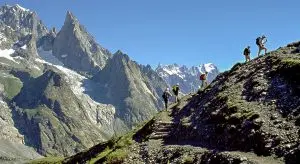
The hiking trails on Mont Blanc don’t really have an “off season”, but in Spring and Fall you might see a few less folks on the mountain. Like most places, the warmer the weather gets, the more hikers appear on the trails. You’ll need to be careful of early and late season storms and snowfalls, too.
Mont Blanc should be on every hiker’s bucket list, regardless of age…just be sure you are prepared physically for the difficulty level, and you’ll come back with memories…and pictures…of one of the world’s most beautiful areas.
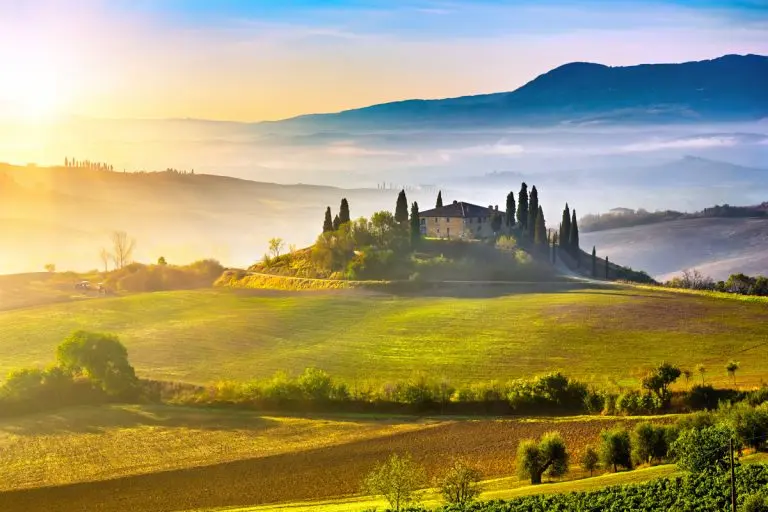
5. Tuscany
The central Italian region of Tuscany is famous throughout the world for many things…birthplace of the Renaissance, classic Italian scenery, medieval castles, Roman ruins, wonderful cuisine, and fine wines. All of these elements complement each other perfectly and are what many would consider to be some of the best Italy has to offer. In my opinion, there is no better way to experience all of these features than on foot…walking through the Tuscan countryside, marveling at the scenery all around you, exploring the medieval castles and Roman ruins, and enjoying a picnic under the olive trees of the phenomenal cuisine and world-class wines. THAT, my friends, is what Go Get Lost is all about!
The trails in Tuscany tend to be Easy to Moderate but unfortunately are often marked haphazardly. I’ve been hopelessly lost in more often in Tuscany than in anywhere else in Italy, hands down! For this reason, I feel it’s imperative you have a good trail map, a compass, and enough Italian vocabulary to ask directions at the next farmhouse. Many of the best trails in Tuscany offer classic postcard views of rolling hills, vineyards, and castles. The types of views that embed themselves in your memory. And the post-walk amenities are among the finest to be had…not only the cuisine, but the warmth of the people and the ambiance of the cities and towns.
Hiking and walking in Tuscany starts sometime in late April, after the spring rains have ended. Wild poppies blanket the landscape, and temperatures warm up to comfortable levels. May and early June are stellar. July sees the fields of sunflowers putting on a spectacular show, but temps are beginning to get very warm, and tourists are becoming more numerous. August can be very hot and crowded; I don’t normally recommend this period. September and October bring cooler weather, and the grape harvest begins. This is a wonderful time to be out in the Tuscan countryside. By November you are running into rain and much cooler temperatures, and you should probably hang up your walking sticks…at least in Tuscany.
6. The Amalfi Coast
The Amalfi Coast holds a special place in my heart. This is where I hiked and explored to lay out one of the first itineraries for our original company, Lost in Italy, back in the 90’s. Since then, I’ve taken hundreds of people on walks and hikes all over the region, I never tire of introducing my hiking clients and friends to this wonderful area. And why should I? On your first walk it will become clear just why this place has been popular with visitors since the Roman emperors built their first “getaway-from-Rome” villas here. The walks along the coastline offer views that are simply spectacular.
The landscape here is typified by craggy mountains whose slopes plunge precipitously into the sea. As a result, the difficulty level of most of the walks are in the Intermediate level, with a few reaching Challenging. Lots of ups and downs, with many of the trails having very uneven surfaces, and even some scrambling over large boulders can be encountered. Trails are inconsistently marked, and a good map is a must…a local guide can be helpful with “not getting lost” and imparting lots of local historical knowledge, too.
The cuisine of the area is markedly different from the north and central regions of Italy, as is the local vintages. Experiment and enjoy the regional fare as you pass through the many villages that dot the coastline here.
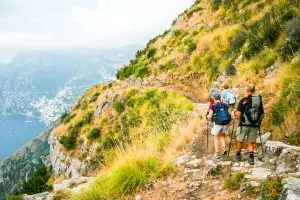
Spring and fall are the prime months for hiking the Amalfi Coast. Cool mornings, warm sunny days, and pleasant evenings are the norm. If you find yourself on the Amalfi Coast trails during July and August, make sure you have sun protection and plenty of water. Many of the trails, especially the most popular ones along the south side of the Amalfi Peninsula, are very exposed to the sun for most of the day, with very little shade. All the better to enjoy the stunning views!
7. Sicily
When exploring on the isle of Sicilia, even those travelers who are very familiar with the varied regions of the Italian peninsula often have to remind themselves they are still in Italy. The arid mountainous terrain seems more like the north coast of Africa than Europe. Some of the best walking and hiking areas (and my personal favorites) are concentrated along the east coast near Mt. Etna and on the hauntingly beautiful Aeolian Islands sprinkled off the northeast coast.
While hiking on the lower slopes of the massive active volcano of Mt. Etna, expect genuine Sicilian villages and forested hills. As you get to the higher altitudes, the trees and warm temperatures soon give way to a surreal landscape of ash slopes and smoking fumaroles. Even in summer hikers on Etna can experience cold and windy weather, extra layers of clothing are a must. The more challenging conditions are more than offset by the unreal views that span a huge chunk of the island. If you find yourself hiking on the Aeolian Islands, you’ll be near sea level and drinking in spectacular views of nearby islands, beaches, and the deep blue Mediterranean. There’s a distinct tropical vibe here…think “Caribbean meets Italy”.
Whether you’re on Etna or on the islands, in fact no matter where you are in Sicily, you’ll find a feast of seafood, local pasta, regional wines and traditional Sicilian desserts like Cannoli and Gelato. Just the type of stuff to recharge after a long day on the trail!
Most of my favorite Sicilian trails are in the Easy and Moderate categories, not too steep but usually taking a full day to complete. Trails are rarely marked, and good sense of adventure is necessary if walking cross-country on your own. Guides are a good idea no matter where you’re hiking, and on most of Mt. Etna they’re required.
The best seasons for hiking most of Sicily are the spring months (think wildflowers galore) of April and May, and the classic fall period (think grape harvest) of September and October. The summer months can be brutally hot, especially in the center of the island, and the winter months can often be cool, windy and rainy.
For all your travel questions feel free to contact me at Jeff@GoGetLost.com
